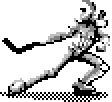|
|  |
| INTRODUCTION |

The ULTIMATE portable gaming system!
Atari, NEC, Sega: These are just a few of the powerhouse firms that tried
to wrest control of the handheld video game market from the mighty Nintendo.
Despite these companies' best efforts, including the introduction of vastly
superior hardware, “Big N” and its monochromatic Game Boy remained
dominant. Eventually, most of the competitors threw in the towel to remain focused
on their more profitable products.
Enter Tiger Electronics, who in the late '90s decided it was time to launch its own
“Game Boy killer.” The company, which was famous for its low-cost,
simple yet addictive LCD games, figured it had enough funds, know-how,
and marketing muscle to put a sizeable dent in Nintendo's market share. Armed
with scores of licenses to develop into software products — from video
games to television shows to Hollywood films — Tiger had a lot of
opportunity to dangle big name titles in front of tantalized consumers. And
so it came to pass that the game.com, which hit the market in 1997, was to be
the company's next big success: or so Tiger hoped.
The game.com, which took its name from the dot-com bubble of the 1990s, was
similar to the Game Boy in that it had a monochromatic display and used
interchangeable game cartridges. However it also boasted some unique features
that were perhaps ahead of their time, such as a touch screen and basic internet
connectivity. Initially, the tech buzz surrounding Tiger's new product was
fairly positive and optimistic. But once the game.com went on sale, it was
virtually ignored by both the press and its target market. After limping
through nearly three years on the market, with underwhelming sales and a generally
negative consumer reception, the game.com was quietly retired in 2000.
So what went wrong? A myriad of things. To name a few: the machine employed
a slow processor and a very blurry screen, offered laughable musical capabilities,
had a small software library of mostly mediocre titles, its touch screen was
impractical, et cetera. And it certainly didn't help when Nintendo introduced
its Game Boy Color in late 1998. Indeed, the game.com was far too little, far
too late and is generally remembered as the ultimate black sheep of the handheld
video game market, rather than the ultimate portable gaming system it aspired
to be.
This website is my best effort to preserve the memory of the game.com, for
any and all who may be interested in it both now and in the far future. So,
like it or hate it, the game.com is here to stay.
|
| |
U P D A T E S |
|
• December 4, 2024
Has it really been two years since the last update?! Good.
Ahem! Today I've added a recent interview with a graphic artist who formerly worked
for Tiger Electronics in Hong Kong. Said artist wishes to remain anonymous, which
is perfectly understandable considering how the game.com is the topic of discussion.
Click here to view past updates. |
| |
C R E D I T S & T H A N K S |
|
Brandon Cobb : It's yours truly! I'm a video game archaeologist, tireless
scanner of documents, webmaster extraordinaire, and... casual game.com
enthusiast. This website is my “gift” to anyone and everyone who
is curious about this strange, mysterious, underdog machine.
Peter Trauner : For doing extensive hardware research about and
writing technical documentation for the game.com, as well as authoring the
first publicly available game.com emulator, he deserves a gigantic pat on
the back.
Jay Oster : This fellow kindly provided me with the official game.com development
kit, without the aid of which I never would have embarked on this most ignoble quest.
Dave Nelson : He “upgraded” my game.com to deliver the crystal
clear sound necessary for me to... make high-quality recordings of awful
game music.
Hannes Drexl : The freelance pixel artist who provided some “dot art”
renderings of the game.com systems, and colored logos, for this website. They fit
right in! |
| |
H E L P M E |
Although I'm frequently hunting high and low for gaggles of game.com goodies,
a bit of assistance is always appreciated. SO! If you can help in any way with
my game.com research by, for example, providing any system, game, or accessory
information not already featured here, scoring me some game.com development
hardware, software, or prototypes, or helping me contact former developers,
manufacturers or distributors involved with the game.com so we can have a
little chat, I'd greatly appreciate it!
|
The game.com debuted while I was in high school. It first caught my eye via a
hype-fueled, attitude-injected TV commercial that featured, among other things,
Duke Nukem 3D. An avid PC gamer, I loved that game and daydreamed about how
“awesome” it would be to play it wherever I went. But it wasn't
meant to be: I couldn't afford to buy the game.com and, once a friend had
gifted me a Game Boy Pocket and a copy of Pokémon Blue, I quickly forgot
all about Tiger's product.
|  |
Years later I would recall my brief teenage longings for the game.com, and finally
buy the system and all the games. I didn't have high expectations for any of it,
which was a good thing because every game was a major disappointment. In the
end, researching the game.com turned out to be more enjoyable than actually
playing it. This website exists to share what I've discovered.

| Thanks for visiting. I hope you enjoy learning some neat, new factoids about
the game.com and its game library.
|
|
|
|